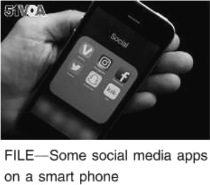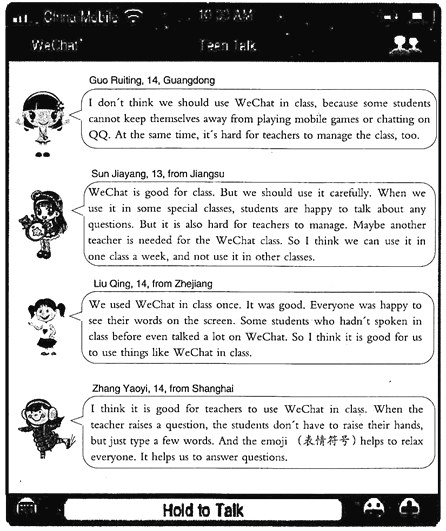-

Mobile phones have changed the way we communicate, but people disagree on whether the devices are useful tools for education.
Students can be easily distracted by their phones during class. Are they listening to the teacher or texting their friends? Are they taking a picture of a quiz to cheat?
School officials, teachers and parents are all trying to find out the best way to supervise students’ use of mobile or cellphones.
In the Canadian province of Ontario, officials are restricting (限制) phone use during teaching time. However, there are exceptions for classroom activities, health and other emergencies.
France passed a law in 2018 banning (禁止) the use of cellphones in schools for students up to age 15, the age when they go to high school.
Last July, a new law was signed in California. It says state public and charter schools can ban students from using smart phones in class and at school. It does not, however, say schools are required to completely ban the devices. There are exceptions, which include emergencies or problems related to health.
So, the officials turned to technology for answers. San Mateo High School now locks up cell phones during the day in a special container. Each student must put his phone away in small bag with a kind of lock. At the end of the day, students unlock the bag with a device.
Other schools are choosing simpler answers to the problem—they ban cellphones in classrooms. “They wanted to provide a clean break for students and not have the frenetic energy that can happen if kids start texting each other or social-media posts start going,” Behm said.
Education Week found that more than 30 schools, and in some cases school districts, have put in place some kind of restrictions during the current or last school year. Districts across the country also have their own ways of phone restrictions both formal or informal.
Toth said students have grown up with cellphones, and “it is our responsibility to teach them correct use for tools within the classroom.” He added that schools are teaching about cellphones and how to use them with social media and the Internet.
“It is part of changing education for kids,” he said, “as long as we teach them to use them responsibly.”
The technology is here, Toth said, schools should use it to help students, and not fear it.
1.From the passage we can know _________.
A.the students in Ontario aren’t allowed to use mobile phones
B.a high school student can use cellphones in schools in France now
C.bringing smart phones to school breaks the new law in California
D.most people think mobile phones are useful for school education
2.The writer probably agrees ________.
A.students should be banned from using smart phones at any time
B.teachers shouldn’t return students’ cellphones during class break
C.each school finds its own way of cellphone restriction
D.teachers should face the cellphone problem and teach its correct use to them
3.The underlined word “frenetic” probably means ________ in Paragraph 8.
A.wild B.worried C.peaceful D.anxious
4.Which of the following may be the best title of the passage?
A.Should Schools Ban Mobile Phones? B.Do We Need to Change Our Ideas?
C.Best Way to Supervise Students. D.Mobile Phones Belong to Technology.
-
— WeChat has changed people’s life in many ways.
—________. We can use it to communicate with others conveniently (方便地).
A.Completely B.Probably C.Exactly D.Possibly
-
The Internet has changed the ways people communicate, work, shop and learn. The latest Internet technology gives you even more ways to share and work with others.
On the Internet, you can p1. your thoughts, experiences, pictures and videos. Post all your pictures and as many videos as you like on You Tube. Additionally, after you upload something to one site, you can often post it to another, like your blog. With pictures and videos, your blog can become a r2. of your experiences!
Tags, or keywords, help keep blog posts, pictures and videos organized. Label your posts with tags that describe what you have uploaded. When you need to find something l3., simply type words in to the search field. The correct post will come right up!
New Internet tools help you work with others better. Wikis are websites that can be edited by multiple people at the same time. For example, Wikipedia is an o4. wiki encyclopedia that anybody can add to or edit.
Wikis help people work t5. more efficiently on projects. Users communicate in one common place rather than sending e-mails back and forth. Many companies, schools and individuals find that wikis are u6.. For example, coworkers at different offices can use one to work on a project. Wikis also have a feature that keeps track of changes made to the document. PB wiki, Wet paint and Wiki spaces are all great places to learn how to make and use a wiki.
New technology lets you participate even m7. in your Internet experience. Start trying out these new tools, and discover all the things you can do on the Internet!
-
The mobile phone has changed people’s life a lot ________ it was invented.
A. until B. since C. before D. after
-
The mobile phone has changed people’s life a lot ________ it was invented.
A. until B. since C. before D. after
-
The mobile phone has changed people’s life a lot ________ it was invented.
A.until B.since
C.before D.after
-
The life we were used to ________since smart mobile phones rushed in.
A. has changed B. changed C. changes D. changing
-
There __________ great changes in the smart mobile phones in the last few years.
A. was B. have been
C. has been D. were
-
WeChat is becoming an important way for people to communicate in daily life. But have you imagined that students can use WeChat in class? Is that an effective (有效的) way for students to learn? Here are some students’ opinions.

1.In Guo Ruiting’s idea, ________.
A. it’s necessary to use WeChat in class
B. the teacher cannot control the class easily
C. students will not play games or QQ in class
D. the teacher should use it carefully
2.Sun Jiayang agrees that ________.
A. students should use WeChat once a week
B. one teacher is enough in a WeChat class
C. students can use WeChat in any class as they like
D. the teacher is happy to talk about any questions when using WeChat
3.In Liu Qing’s class, ________.
A. students always use WeChat in class
B. students are not excited to use WeChat
C. WeChat can make students more active
D. everyone can only see their words on the screen
4.Zhang Yaoyi’s classmates can use WeChat to ________ in class.
A. chat B. answer questions
C. practice typing D. raise questions
5.We can learn that in the four students opinions, ________.
A. WeChat is a waste of time in class
B. students can use WeChat at any time
C. WeChat should be used properly in class
D. both teachers and students like to use WeChat in class
-
Mobile phones and the Internet have improved our life in many ways. However, along with improvements, they have also brought a number of worrying problems.
Many car accidents are caused by mobile phones. You can use many new mobile phones to get on the Internet. This can be very convenient, but some drivers get on the Internet while driving. Driving needs all our attention. By looking at their mobile phones and not at the road, these insensitive drivers are dangers to us all.
Many of the dangers of the Internet are well known. Children who visit websites without their parents' permission sometimes talk to older people they don't know and put themselves in great danger. People with blogs sometimes post embarrassing photographs of people they don't know on their websites without permission. There are also people who use the Internet to get personal information that we do not want them to have.
Mobile Phone and Internet Safety Tips
◇If you need to use a mobile phone while you are driving, use a “handsfree” phone.
◇In difficult driving situations such as rain or snow, do not use your phone at all.
◇Do not make very important phone calls while driving. They take your attention off the road.
◇Tell your children not to talk with anyone they do not know on the Internet.
◇In an embarrassing situation, pay attention to people around you. People will be shy about taking your pictures if they know you're paying attention.
◇Refuse to give out any personal information on the Internet.
1.Which of these dangers of mobile phones or the Internet is NOT mentioned in the passage?
A. You can have a car accident if you use your mobile phone while driving.
B. Someone can post your photographs on the Internet without your permission.
C. Someone can get your personal information.
D. Someone you do not know can call you.
2.A “handsfree” mobile phone is probably a mobile phone that ________.
A. is free to use
B. can be used without your hands
C. can be used with only one hand
D. can be used only in cars
3.What advice is given in the passage to stop someone from taking an embarrassing picture of you?
A. Pay attention to the people around you.
B. Don't give out your personal information.
C. Use a “handsfree” mobile phone.
D. Wear your camera phone on your belt.
4.Which is the best title of the passage?
A. Internet Problems
B. Mobile Phones and Internet Dangers and Safety Tips
C. The Development of Mobile Phones and the Internet
D. The Advantages of Mobile Phones and the Internet

